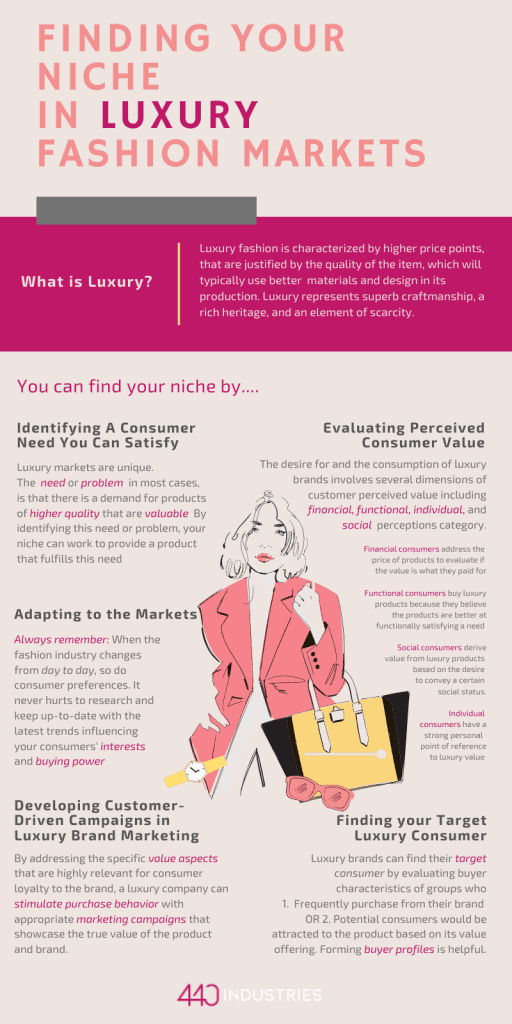Introduction
The luxury industry is loaded with valuable markets that are continuously growing. It is important for brands to research consumers’ reasons for buying luxury, their opinions and beliefs about what it is and in what way consumers’ perception of luxury value can affect their buying behavior. Doing so is a necessary strategy for finding a niche that is lucrative for their business. Even though the luxury markets may seem difficult to break into, they present excellent opportunities to earn high profit margins on products or services.
In this post, we’re going to break down the values that drive these luxury purchases, different strategies for finding your niche in luxury markets, and elements you need to build a good marketing strategy for your luxury brand.
- What Does It Mean to Be A Luxury Brand?
- Identifying A Need You Can Satisfy
- Examining Consumer Perception of Luxury Value
- Finding Your Target Consumer
- Developing Customer-Driven Campaigns for Luxury Brand Marketing
- Adapting to Changes in Luxury Markets
- Conclusions
1. What Does It Mean to Be A Luxury Brand?
Due to the variability of the concept, different people define luxury in different ways. Most agree that the perception of luxury depends on two main subjects: the context and people concerned.
Others say luxury is defined by high price points, placing it outside the category of goods that are simply necessary for daily life. This high price point is justified by the quality of the item, which will typically use better quality materials, design expertise, and craftsmanship in its production.
Here is a list of common characteristics associated with most luxury brands and products:
- Price: The brand offers products that are the most expensive their category.
- Quality: The brand offers top-of-the-line products, which gain in value over time and will likely be repaired, rather than thrown away.
- Aesthetics: Whenever and wherever the brand is seen, it exemplifies a world of exquisiteness and elegance.
- Rarity: The brand limits its production and focuses on hyper-customization for consumers.
- Extraordinariness: The brand offers surprising and unexpected products, leading the most popular fashion trends.
All in all, luxury brands are associated with a high perception of value. Luxury isn’t just products, but rather an entire experience. For many fashion brands, getting to this point takes time and a ton of investments, the payoff is worth it.
Once a brand establishes a reputation for its luxurious value, it can start to branch out into other product lines, which is why we might come across items we wouldn’t necessarily think of as luxurious. Branching out with uncommon product lines are part of the process of finding a niche to serve.
For fashion brands just starting out, they must begin by identifying a problem or need their target consumer is experiencing to lead them to a niche. Let’s break this down further.
2. Identifying A Need You Can Satisfy
When it comes to selling luxury goods and services the first step is identifying a problem or a need your niche will serve to alleviate. Luxury markets are unique. The “problem”, in most cases, is that there is a demand for products of higher quality. Also, there is a demand for ways to obtain the perceived value of luxury items provide to consumers.
For example, your niche might solve the need of enhancing consumers’ social status by providing them with an impressionable piece of clothing. Or perhaps you notice there is an underserved market for luxury sports attire in a certain region and your niche offers to bring products to that area.
Asking yourself these questions can help you identify a potential problem or need:
- What are popular trends in the fashion industry?
- What are the activities my target consumer is participating in?
- Are there companies not providing solutions to your consumer needs?
- What is the unique feature of my product?
- Who does my product benefit?
As we will learn in the next sections, luxury buyers are not just looking for something to solve a problem, but rather something that brings additional value to them. Something that fosters emotional connections and brand loyalty.
3. Examining Customer Perception of Luxury Value
Recent studies have concluding evidence that the desire for and the consumption of luxury brands involves several dimensions of customer perceived value including financial, functional, individual, and social consumer perceptions.
Even if consumers buy the same luxury goods, their perceptions about luxury values can differ, and these perceptions are driving forces for continuing to purchase these items. What does this mean for luxury marketers? It means there are specific reasons luxury buyers continue to purchase luxury items, and not just because they can afford to.
According to this study, a consumer’s perception of luxury is defined in four areas: financial, functional, social and individual with sub areas in each.
- Financial: The financial area addresses the price of these products and if the consumers feel they are receiving what they paid for.
- Functional: Functional consumers buy luxury products because they believe the products are better at functionally satisfying a need. Within this category are the Uniqueness, Quality, and Usability values:
- Uniqueness: Product is perceived to be exclusive or rare
- Quality: Product is perceived to be of better quality because of its association with a luxury brand,
- Usability: Product is perceived to be able to perform well and deliver expected results.
- Social: Social consumers derive value from luxury products based on the desire to convey a certain social status. Within this category are Conspicuousness and Prestige values.
- Conspicuousness: People who are looking to demonstrate their status in the presence of other people perceive conspicuousness value from luxury.
- Prestige: Prestige value influences consumers buy luxury because others in their community are buying luxury and fitting in is a status symbol.
- Individual: Individual consumers have a strong personal point of reference to luxury value. Hedonic, Self-Identity, and Materialistic are values in the individual dimension.
- Hedonic: Products is perceived to deliver strong feelings of happiness, comfort, and beauty.
- Self-Identity: Product is perceived to bring symbolic meaning into an individual’s life.
- Materialistic: Product (along with the purchase of many others) is perceived to be a metric of success.
Value perception can be used as a base for customer segmentation. Businesses should be aware of these reasons in order to assess which type of consumer fits into their target market and devise better strategies to attract more customers to their niche.
4. Finding Your Target Customer
Once you a compile a list of potential problems in need of solving and understand the influence of value perception of consumers, you can start to segment out your target market of consumers based on how effectively you can meet their needs and fulfill the value expectations. The better you can serve this demographic, the more loyal they will be to your brand.
Luxury brands can find their target consumer by evaluating buyer characteristics of groups who purchase the most frequently from their brand or from other brands they may be in competition with. After conducting research, they can form buyer personas.
A buyer persona is a blueprint for selling and marketing to your customers. First, you survey your current and prospective consumers. Then, you take common information shared between all (demographics like gender, age, income, country, and psychological information, like lifestyles, values, and motives) to create buyer profiles.
The goal is to find out the worth your bringing to your current consumers, and how this could applied to new target consumers. In a new study from MindShare North America, researchers categorized 5 different types of luxury consumers according to demographic information and their different perceptions of value.
- Strivers: 24% of luxury buyers view luxury as proof of success. They are mostly middle to upper middle class at the moment and early in their careers. They will eventually work their way into the more elite income brackets.
- Trendsetters: 16% view luxury as a way to set differentiate themselves. They value brands who consistently stay up to date with fashion trends. This is the most ethnically diverse group of luxury buyers, are fall into the age range of 18-40.
- Aesthetes: 17% define luxury as the peak of aesthetics and design. These consumers value exemplary design and craftsmanship.
- Only the Best: 23% view luxury as unsurpassed quality and service.
- Comfort First: 19% view luxury as a way of bringing meaning to life. When making purchases, they’re most likely to be influenced by online reviews and brand websites.
Once you know how consumers think of luxury, and what drives their purchases, it can help you determine the best marketing strategy to attract potential target clients and reduce wasted customer acquisition costs.
5. Developing Luxury-Driven Campaigns for Luxury Brand Marketing
As you begin brainstorming what your luxury product marketing campaign will look like, you have to consider incorporating value points of your target audience. Remember these are the qualities most important to your potential customers.
Here a few tips to guide your luxury brand marketing efforts:
Offer Exemplary Customer Service: Customers are looking to feel special and valued. Go the extra mile to personalize and create value in your customers’ experiences.
Ensure Quality Craftsmanship: Luxury brand consumers expect a certain level of quality. This should be exceedingly high. From design, material selection, and everything in between, make sure you have strong quality control measures in place. Make sure that every product that leaves your manufacturer is of the finest possible quality.
Use Personalized Google Ads: Luxury buyers want to feel like they are special, however, your target consumers are going to differ in terms of income level, age, gender, etc.. If you know a product might disqualify some of your audience because of the price, style, or functionality, refrain from marketing to them. Instead, develop individual ads to target different types of your target consumers.
Run Immersive Campaigns: When you create luxury product marketing campaigns that are tied to the things that influence your buyers, you naturally forge deeper connections. This all-encompassing form of marketing includes, samples, digital marketing, word-of-mouth ads, public relations, and other marketing techniques. You should have a well-designed website and social media presence before sending out online surveys, blogs, radio and television advertising, flyers, and billboards.
Hold Exclusive Release Events: To appeal to the consumers who enjoy the rarity and exclusiveness of luxury products, holding a limited event for a release of a brand new product could be fun and exciting. Smaller events are the perfect way to connect with your consumers and show them their business matters.

6. Adapting to Change in Luxury Markets
In a high growth industry like this, it would be ideal to hit the ground running, but sometimes consumers go through behavior changes in luxury consumption which in turn affect your brand’s positioning.
Take the global financial recession for example. This recession prompted changes in behavior and preferences toward luxury in different ways, such as renting luxury goods instead of buying them. Another example is the rise of consumer interest in sustainability. New terms are now aligned with luxury such as eco-awareness, green consumption, ethical lifestyle.
So, how do you keep the luxury machine churning?
At its core, luxury product marketing requires you to be flexible. As we’ve learned, it is not just one type of customer coming through the door, but many, often with different intentions and needs to satisfy.
The one method that never fails is being aware of your consumers needs and wants. It is important to stay on top of the changes in the wealth and interests of your luxury consumers so you are prepared for any sudden changes.
7. Conclusions
So far, we covered some very useful tips for finding your niche in the luxury fashion market!
Remember, the key steps to finding a suitable niche starts with identifying a problem or need experienced by consumers. If this need isn’t being properly satisfied by other competitors, and your brand has a product that will, you’ll have a great head start.
From that point, analyzing different consumer perceptions of luxury will help you nail down your target consumer base even further.
And finally, once you have a solid idea of your perfect consumer, you’ll be able to create relevant and engaging marketing campaigns to attract them to your business.







